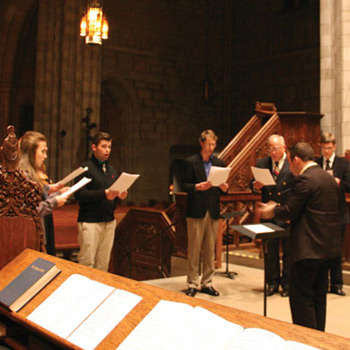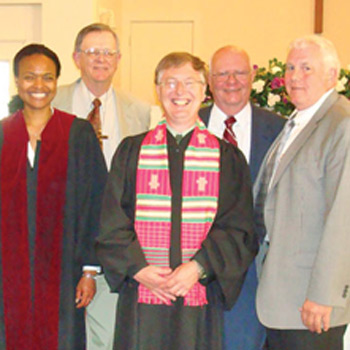This is the third in a series of articles about the rapidly changing environment of theological education. The first article, “More Schools, Fewer Students,” appeared in the Autumn 2013 issue and is available at www.intrust.org/moreschoolsfewerstudents. The second, “Charitable Giving and Your Seminary,” followed in the New Year 2014 issue and is available at www.intrust.org/charitablegiving.
Three phrases describe the challenges that seminary leaders face in 2014: more schools, fewer students, and declining financial support. That was the big picture we painted in our two previous In Trust articles (which you can find via links below). If we stopped now, you might be tempted to resign from board membership or step down from administrative service. But take heart!
In this article we offer examples of several best practices, tested in the field, for garnering financial support from individuals, congregations, denominations, and foundations. We’ve based these insights on a decade of peer research conducted at accredited seminaries of various sizes, along with our own experience in the field. These best practices share certain traits:
-
Strategic. Best practices in fundraising require intentional, focused activity on the part of the board, the president, and the chief development officer.
-
Spiritual. Our research is undergirded by the work of Henri Nouwen (author of The Spirituality of Fundraising) and Thomas Jeavons and Rebekah Burch Basinger (authors of Growing Givers’ Hearts: Treating Fundraising as Ministry), who demonstrate how board members, presidents, and development professionals can nurture the spiritual growth of givers, encouraging them to grow in the grace of giving.
-
Scalable. Best practices in fundraising can be adapted to any budget, which means you can apply them at your school whatever your level of resources.
Building individual support
While accredited theological schools across the board report inconsistent giving from year to year, we’ve found that strategic activities can lead to ongoing and even increased support from individual givers.
 |
| Click image to enlarge. |
Many experts claim that the traditional “80/20 rule” is becoming the “90/10 rule” or even the “95/5 rule,” which means that 95 percent of the support for a seminary may come from as few as 5 percent of constituents. In light of this, we suggest that the seminary’s development office assign the top 25 supporters (based on total annual giving) to the president for quarterly cultivation. This can take the form of phone calls, e-mail messages, or face-to-face visits. The chief development officer should also connect the president to emerging key prospects.
Ideally, a president will commit to engaging at least two supporters per week, although presidents who excel may want to set a goal of one contact per day. Presidents who don’t consider fundraising part of their job, or fear it, occasionally shun development work. Sometimes they even cite the second chapter of James, which warns against showing favoritism toward the wealthy. But the New Testament shows another view of fundraising as well — for example, Paul raised money among the Greek Christians to benefit the Jerusalem church, and he often corresponded with and visited his chief supporters and partners throughout the Roman world, as his letters make clear.
After assigning the top 25 supporters to the president, the chief development officer can take responsibility for contacting the next 250, while at the same time responding to new prospects. That means the development head would average about two personal development contacts per day, using a variety of communication channels. The development chief must also oversee communication with the remaining 80 percent to 95 percent of constituents via multichannel communication efforts — direct mail, email, social media, and special events.
It’s important to note that the chief development officer’s personal attention to the next 250 individuals is valuable regardless of the size of their gifts. At smaller institutions, this list may include people who give only $100 per year. But because faithful fundraising is first and foremost about shepherding the persons whom God has placed in the care of your institution, encouraging their growth from whatever their starting point is crucial.
 |
| Click image to enlarge. |
What’s the role of the board? A wise board sets its own challenging fundraising target. For example, a board that meets quarterly might set a goal that each member connect personally with one person between meetings — three or four different people throughout the year. With this target, a board of 15 members might make 45 to 60 strategic connections per year. But whatever the goal, a board should find a rhythm of inviting others to join them in doing God’s work.
And it’s not just about dollars! Engaging individuals need not be limited to financial requests. As the board and senior administrators share the school’s vision in a clear and concise way, they open the door to increased giving as people are invited to participate.
Start with the giver and not the gift
In The Sower: Redefining the Ministry of Raising Kingdom Resources, Scott Rodin and Gary Hoag offer a helpful guide for approaching people:
-
Person. Learn who the person is, not just what he or she does.
-
Passion. What facet of God’s work inspires this person’s passion?
-
Permission. Seek permission to talk about your school.
-
Participation. Share how people participate with you in the mission of the institution.
-
Prayer. Encourage the person to pray before responding to your request.
When individuals are approached in this way, the president, development staff, and trustees take the role of colleagues inviting friends and associates into a shared ministry. Seminaries that implement such strategic and measurable best practices widen their school’s support base and do the deeply spiritual work of encouraging people to participate with them in God’s work as God leads.
Building church support
Our research shows that church support for theological schools has been flat or declining in the past decade, and data from the Association of Theological Schools confirms this. On the other hand, some theological schools have seen growth or even upward spikes in church engagement. Those with more support have told us about three activities that have helped them engage with their supporting congregations and denominations.
First, schools that integrate their approaches to congregations both recruit more students and build more financial support. Whether the president is asked to preach on Sunday or a professor teaches a Bible class on Wednesday night, that person is an ambassador for the seminary, and members of the congregation ought to have the opportunity to learn more and discover opportunities for engagement. This requires training and coordination by the advancement, church relations, and recruitment staff, as well as the president’s office, but it pays off over time. Congregations can be significant partners in our work.
Second, our research shows that seminaries that put specific projects or scholarship funds in front of congregations are more likely to increase their annual support. What tangible projects could your institution be promoting in church settings?
Third, theological schools with good communication and adequate resources are more likely to enjoy stable or increased support. For example, using church events or denominational media to announce scholarships or projects can keep church members informed and engaged in the work of the theological school, which otherwise goes unnoticed by people in the pews.
What are some practical ideas for engagement? We know of one seminary that provides every one of its supporting congregations with a small book linked to creeds and other doctrinal issues of the Christian faith. Many congregations purchase these resources in bulk, which strengthens the faith of everyday Christians and also attracts increased and more consistent financial support for the school. Another school that we know of partners with local congregations to teach planned-giving seminars for lay people, with a specific focus on giving to the church.
If your seminary is weak at integrating its efforts, it may be time to improve in this one particular area. Data from the Association of Theological Schools show that one of the leading reasons for a student choosing a particular seminary is prior contact with someone at that seminary, such as a professor. If your development and admissions office are not working together, you’re missing out in two ways.
Promoting planned giving
The constant need for annual support can tempt even the most mature leaders to give less attention to planned giving. Needless to say, on-the-ball seminaries don’t let that happen.
Some seminaries have staff members dedicated just to planned giving. They often generate leads by hosting seminars on campus or at partner congregations, usually featuring a faculty member who presents biblical or theological reasons for giving and a development officer who explains tax benefits and walks participants through the steps. But if your development staff lacks the time or expertise to offer seminars, there are other cost-effective ways to provide planned-giving services.
First, some schools outsource these efforts, retaining an outside firm to respond to financial questions and offer technical assistance because leaving a legacy is becoming increasingly complicated in the ever-changing legal landscape. The development staff just passes along the leads, and the vendor follows up with givers.
Other schools alternately resource these efforts by funding planned giving staff and activities through the endowment or a seminary foundation. In this scenario, the salary, benefits, and budget of the planned giving director are considered a long-term investment, so there is no current drain on the development budget.
Finally, many seminaries set up separate foundations to accept planned gifts. A separate foundation ameliorates the difficulty that some schools have with managing complex transactions, administering trusts and charitable annuities, and processing real estate gifts. Seminaries with separate foundations sometimes find that they have opportunities for volunteers who have experience in the financial sector. Who doesn’t want retired bankers, brokers, and barristers helping out from time to time?
Building foundation support
Foundation support for theological education was up 121 percent during the past decade and now represents one-third of all support to members of the Association of Theological Schools. Consider that! In the 10-year span that encompassed the “great recession,” individuals and congregations struggled to keep supporting theological education, but foundations stepped in to fill the gap — and then some. Nevertheless, garnering foundation support requires significant work, and discovering which foundations are in tune with your seminary’s particular mission is the first and most challenging step.
How can a seminary on a shoestring budget gain access to grants? At the most basic level, hire a student, a part-time staff member, or full-time employee to research foundations that support schools like yours in your geographic area. Get help from resources from the Foundation Center (www.foundationcenter.org) and Guidestar (www.guidestar.org). And if you get a first grant, remember that the possibility of a second grant is likely based on the quality of your first grant’s report.
Where to begin? Take action, with trust in God’s grace
Over the course of three articles, we have tried to identify the difficult realities of theological education and offer solutions based on research and our experience.
By taking action, the board, the presidential leadership team, and other stakeholders can strengthen theological schools to carry out the vital task of preparing leaders for ministry and service in God’s church.
Ultimately, though, growth in generosity is not simply a result of appeals or proposals, but is rather the work of God’s Spirit stirring people’s hearts.
In Galatians 5:22-23, Paul outlines the “fruit of the Spirit,” which, he says, include “love, joy, peace, patience, kindness, generosity, faithfulness, gentleness, and self-control” (NRSV). That’s one of the best reasons we believe seminary leaders should take steps to encourage growth in generosity in the lives of their friends, graduates, supporters, and others.




























